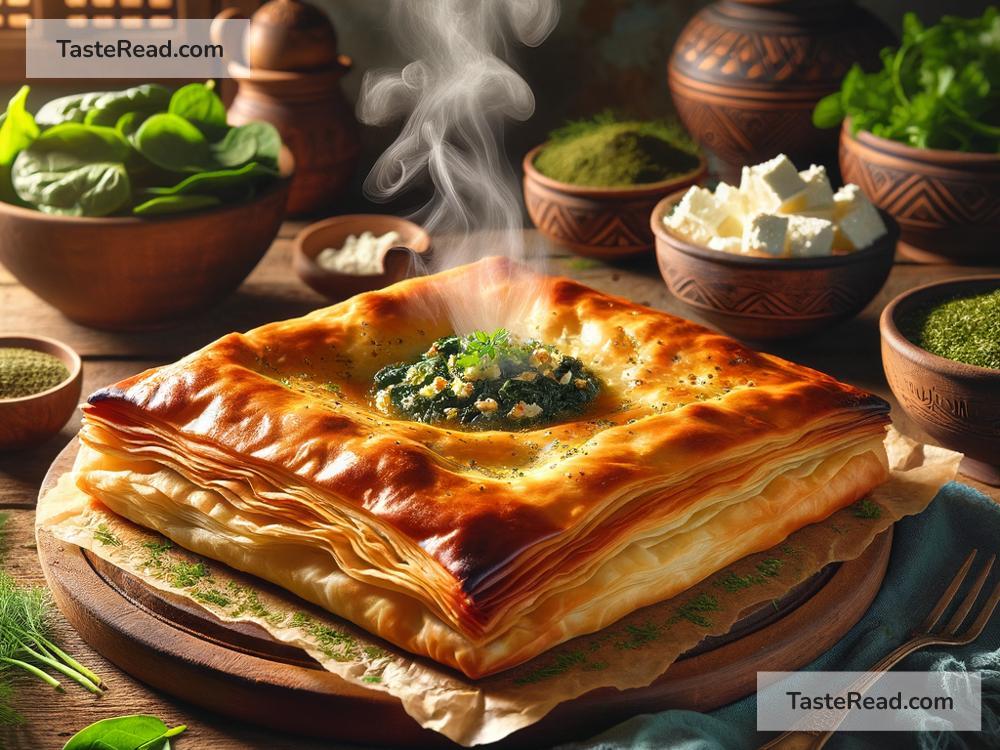Authentic Greek Spanakopita: A Recipe Tradition Explained
Greek cuisine is famous for its rich flavors, fresh ingredients, and timeless traditions. Among its many beloved dishes, spanakopita stands out as an iconic comfort food. It’s crispy, savory, and bursting with the flavors of spinach and feta cheese, all wrapped in delicate layers of phyllo pastry. But spanakopita is more than just delicious—it’s a cultural tradition that has been passed down through generations in Greece. If you’re curious about this classic dish and want to learn how to make it yourself, you’ve come to the right place!
What Is Spanakopita?
Spanakopita (pronounced spah-nah-KO-pee-tah) is a type of Greek savory pie filled with spinach, feta cheese, and herbs. It’s most commonly made with thin, flaky sheets of phyllo pastry, creating a golden, crispy crust. This dish has its roots in Greek history, with variations of spinach pies found as far back as Ancient Greece. Today, spanakopita is enjoyed worldwide, but in Greece, it often has a place at family meals, holiday celebrations, and gatherings with friends.
What makes spanakopita so special is its combination of simple, wholesome ingredients, expertly layered to create a unique texture and irresistible taste. Though traditionally made as one large pie, spanakopita can also be shaped into individual triangles, perfect for appetizers or snacks.
What Makes Authentic Spanakopita Authentic?
An authentic spanakopita recipe sticks to traditional Greek ingredients. These include fresh spinach, tangy feta cheese, olive oil, and aromatic herbs such as dill and parsley. Some variations may include green onions or eggs as binders, but the key to true authenticity is to focus on quality. Greeks often use fresh, locally sourced ingredients to make this pie, ensuring the flavors shine through.
Phyllo pastry is another essential component of spanakopita. Phyllo (filo in Greek) is a thin, delicate dough used in many Greek dishes, such as baklava. The light and flaky texture of phyllo is what sets spanakopita apart as a culinary masterpiece.
While some modern recipes add extra fillings like ricotta cheese or heavy cream, authentic spanakopita doesn’t need the extras. Its charm lies in its simplicity and the way the classic ingredients work in harmony.
The Story Behind Spanakopita
Spanakopita isn’t just about food; it’s also steeped in tradition. In Greece, cooking and sharing meals are a central part of family life. Recipes like spanakopita are passed down from grandparents to their children and grandchildren, making it a symbol of togetherness and shared history.
The strong connection to local ingredients is another testament to Greek culture. For centuries, Greeks relied on what was readily available—spinach growing in the garden, milk for cheese, olive trees for oil. Today, even as recipes spread across the world, this focus on freshness and quality remains essential to authentic Greek cooking.
How to Make Authentic Greek Spanakopita
Ready to bring a slice of Greece into your kitchen? Making spanakopita may take some time and patience, but the steps are simple and straightforward. Let’s break it down into an easy-to-follow recipe.
Ingredients:
- 1 pound (450g) fresh spinach, washed and chopped
- 1 cup (150g) feta cheese, crumbled
- 1/4 cup olive oil
- 2–3 green onions, finely chopped
- 2 tablespoons fresh dill, chopped
- 2 tablespoons fresh parsley, chopped
- 2 eggs, lightly beaten
- Salt and pepper, to taste
- 1 roll of phyllo pastry, thawed (usually 10–12 sheets)
- Extra olive oil or melted butter for brushing the phyllo
Instructions:
- Prepare the Filling:
Heat olive oil in a skillet over medium heat. Add the chopped green onions and sauté until softened. Add the spinach and cook until wilted, about 2–3 minutes. Remove from heat, cool slightly, and drain any excess liquid.
In a large bowl, combine the cooked spinach, crumbled feta, dill, parsley, eggs, salt, and pepper. Mix until all the ingredients are well combined.
- Prepare the Phyllo:
Preheat your oven to 350°F (175°C). Lightly grease a baking dish (typically 9×13 inches).
Lay one sheet of phyllo pastry in the dish, and brush it lightly with olive oil or melted butter. Repeat this step with 5–6 sheets, layering them on top of each other.
-
Add the Filling:
Spread the spinach and feta filling evenly over the prepared phyllo base. -
Top with More Phyllo:
Layer the remaining sheets of phyllo over the filling, brushing each sheet with olive oil or melted butter. Once all the sheets are layered, tuck the edges down to seal the pie. -
Bake:
Using a sharp knife, score the top layer of the phyllo into squares or triangles for easy cutting once baked. Bake in the preheated oven for 45–50 minutes, or until the top is golden brown and crispy. -
Cool and Serve:
Let the spanakopita cool for 10–15 minutes before cutting and serving. Enjoy it warm or at room temperature!
Tips for Success:
- Handle phyllo pastry gently, as it’s very fragile. Cover unused sheets with a damp towel to keep them from drying out.
- Experiment with herbs! If you can’t find fresh dill or parsley, you can add dried versions, though fresh herbs provide the best flavor.
- If you prefer bite-sized portions, you can fold the filling into individual triangles instead of making one big pie.
Bringing Greek Culture into Your Home
Authentic Greek spanakopita isn’t just food—it’s a taste of history, tradition, and family. When you make this recipe, you’re participating in a cultural practice that spans hundreds of years. By using simple, fresh ingredients and giving attention to detail, you can create a dish that not only tastes amazing but also tells a beautiful story.
So gather your ingredients, carve out some time in your day, and enjoy the process of creating spanakopita. Whether you’re sharing it with loved ones or savoring it all to yourself, this classic Greek pie is sure to become a favorite in your kitchen. Happy cooking—Kali Orexi! (Greek for “Bon Appétit!”)


